
There was an article in Slate last week* about how your foodie-ism is an awful snobbish vain planet-destroying thing. Okay, I know, I know, the easiest freelance sale on earth is something contrarian and attention-getting to Slate, like “Why Your Oxygen Addiction Is Killing the Atmosphere” or “Attention Boy Scouts: Actually, Busy Traffic Is Good For Little Old Ladies.” And too often this kind of Puritan deploring of modern habits is vanity in disguise, the modern equivalent of the medieval flagellants who would beat themselves the hardest in public for the attention, declaring “I am the worst of all!” You wish.
Take a statement about trendy farmer’s markets like the following:
It used to be that human ingenuity was valued in the kitchen. Now, what matters more is chefs’ knowing the right producers and buying the right products. Culinary excellence can no longer be achieved simply by learning the right technique; it can be acquired only by knowing the right things to buy—and by, it needs hardly be said, shelling out however much money it takes to buy them. In this way, modern foodies’ materialistic definition of refinement is more exclusive than that of yesteryear’s dogmatic French cooking. What appears to be a celebration of the natural and the simple is in fact more constrictive and less attainable, because it depends not on talent but on means and access.
This is complete insanity, an argument only possible if you know NOTHING, absolutely nothing, about the brutality and forbidding class divides of the classical French kitchen. Remedial reading of Henri Charpentier’s Life a la Henri is recommended. But it also seems to know nothing life as it’s actually lived in 2013, either, because it imagines this world in which chefs and diners are one-upping each other over the provenance of carrots, apparently. And honestly, they are? Who, where? I want names and addresses, because I keep hearing this stuff about these awful entitled annoying locaboors and farmer snobs, and I just don’t find them in real life, anywhere.
I was thinking about this while I was at Sous Rising, an underground dinner experience put on by chef Jake Bickelhaupt and his wife Alexa, which I first really heard about when he was picked to do this Key Ingredient:
That’s his kitchen, and we ate at their table, seven of us, and it was just such a warm, and kindly, and eager to please experience, a communal experience of delight, that it’s simply impossible for me to reconcile a dinner like that with the pinched, sour, grasping notion of modern dining that the Slate piece would have you believe is inevitable now.
Bickelhaupt is young and earnest, like John Cusack in Say Anything, has some fancy experience (Alinea, Charlie Trotter, Schwa) but is also kind of inexperienced in a good way, in that he doesn’t come off like a lifer in the biz already— he’s more like Iliana Regan of Elizabeth, he knows what he wants so much that practical experience is only a small piece of who he is, really. And in any case, the last thing you’d ever say is that he doesn’t know what he’s doing in the kitchen— he and another chef did everything, with hardly a word, turning out something like 21 courses in a standard apartment-sized kitchen, about 4 feet behind my back, and every time you looked at the kitchen, it looked as clean as if they hadn’t started cooking yet.
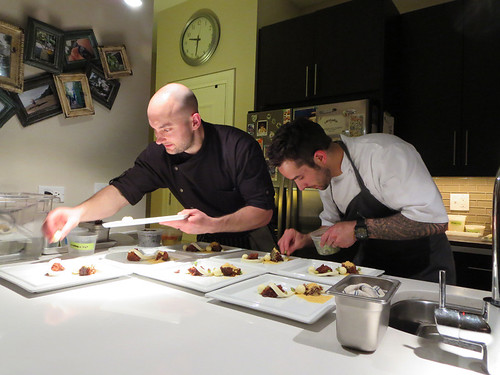
The food, I suppose, came closest to Schwa, there’s a lot of tricky stuff in it as in this “cocktail” which froze one liquid and gelled the other:
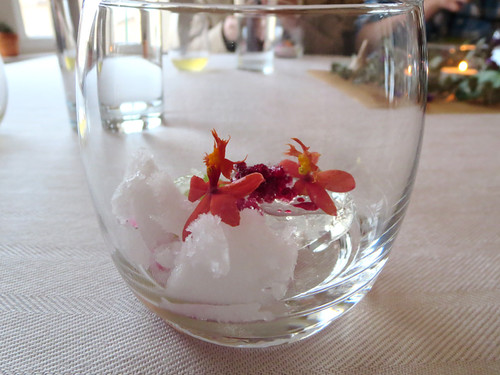
but things were also just plain beautiful, delicate, no matter what music was headbanging in the room at the time. And there’s not only a lot of skill but a pretty good understanding of what people enjoy that goes into a dish like this:
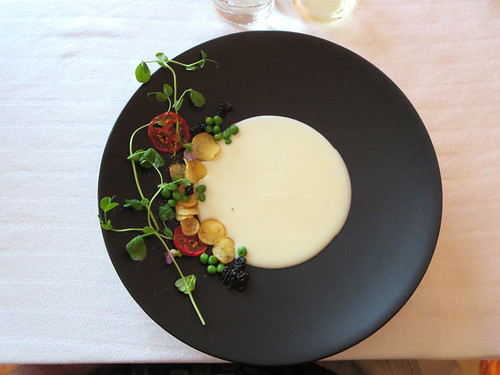
basically, a soup made with the flavors of caviar and potato, including the little fingerling potato chips and the dried tomato slices. It’s pretty, it’s local (note the pea tendrils, on everything this week), and unlike the deconstructed version of this caviar-potato dish I can imagine having at many places, it tasted great, a warming, nurturing dish.
There was maybe one dish I thought was a botched modernist experiment— parmesan puff crisps for scooping up parmesan foam, which sort of crossed the line from cheese smell to puke smell. And I’m going to say right now, this thing of making savory-sweet main courses with cake in the middle of them doesn’t work for me— everyone else was delighted by this duck confit-duck crackling dish in a garden pot, but I wanted something more robust and meaty at that stage in the meal than this:
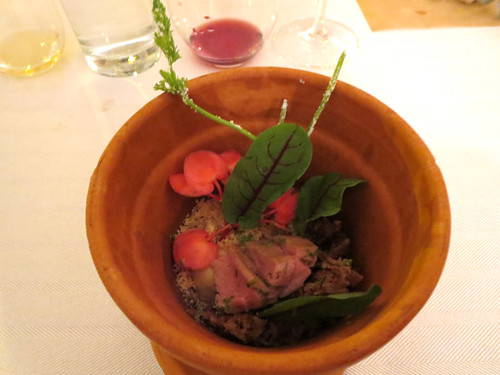
But that’s two out of 21. Then there was this amazing combination of tart, jarring tomatillo broth with delicate peekytoe crab:
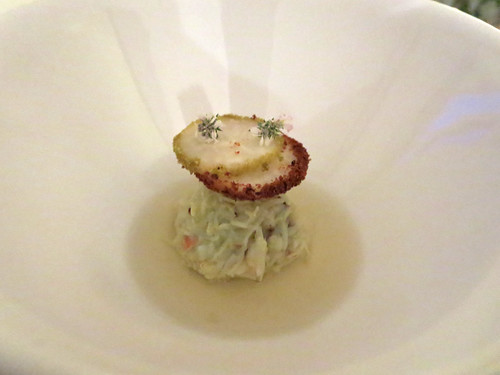
or this sugar-cured beet, as gnarled as a prune, topped with a bit of anchovy and dill:
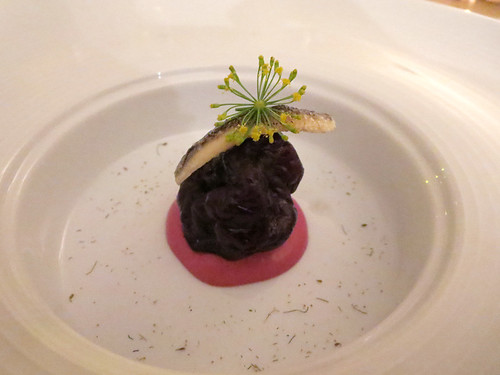
Bickelhaupt said it was his tribute to his Scandinavian ancestry and most guests hated it, but I loved its Nordic plainness mixed with the surprising lushness of the pickled, but not vinegary, beet.
I could go on course by course, but I wouldn’t want to spoil the surprise, and in any case, it’s sort of not the point, I don’t want to do 7 THINGS YOU MUST EAT AT SOUS RISING RIGHT NOW, because in so many ways it wasn’t about the food in a list-the-ingredients sense, certainly not in any my-carrot’s-morally-superior-to-yours way (though I will say that Bickelhaupt seems to have no trouble getting hold of the same things big name chefs use, mostly just with a phone and a credit card). It was about the pleasure of experiencing someone else’s pleasure at making food for you, and the shared pleasure at the table as we had each new thing set in front of us. It wasn’t an entirely new experience— you could analogize it to Schwa, to Elizabeth, to EL Ideas, and to my first dinner of this sort so long ago when Trio in Evanston had just gotten a new young chef named Achatz in who was doing crazy things. Maybe something in fine dining has gotten a little too pinched and status-driven at times, though I’d blame media at least as much as chefs for looking at food in terms of gets and firsts and musts. But all it takes for all that to melt away is one chef to welcome you into his space and make delightful things for you. Well, two chefs and a server-slash-wife— this was, as much as anything, a meal suffused with the happiness of two people who are happy at home:
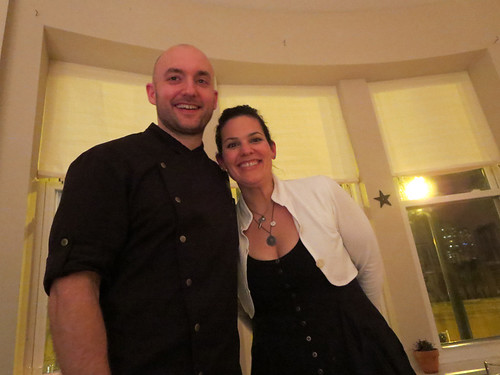
A restaurant is rumored and, surely, inevitable. It will change some when that happens, but in the meantime, go here and book yourself a place at the table of the apartment on the top floor, left.
* Between the time I started this and when I finished it, Whet Moser wrote this excellent piece taking the Slate article down in more detail.
* * *
One son had to be in Glenview for a 4-H meeting. Which gave me just enough time to grab sushi. Wait, why do I associate Glenview with sushi, you ask? Isn’t it a pretty whitebread north shore suburb? Maybe, but all I know is, there’s a cluster of sushi places there. Akai Hana is right off the 94 exit at Lake. Others are a mile away on Waukegan Road. And these aren’t new, trendy, lame-o sushi places for hipsters, but places that have been around for a number of years, mostly Korean-run (like most sushi in Chicago) and aimed, it seems, at an Asian audience.
One called Tatami seemed the most promising and once I circled Waukegan Road three times to find its location at the back of a strip mall, invisible from the street, I knew it had to be good. It’s a small, slightly dated-chic dark room; two chefs stood at the counter, talking in Korean (I assume) to a couple sitting there. Unfortunately, that meant I never had a chance to engage the chef directly to give my standard spiel for wanting him to pick me good stuff that wasn’t all tuna and salmon, and the options for ordering proved pretty thin— there was a $30ish plate that I was warned would be all safe stuff, or a $70 platter for two that had more unusual stuff like fluke or needlefish on it. I seemed to have no choice but to order enough sashimi for two.
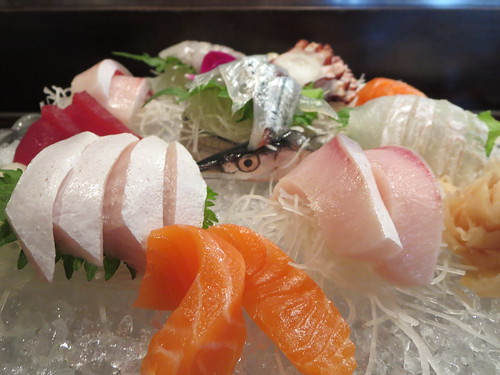
So yes, I ate way more sashimi than I needed to, and to some extent I paid for it the next day, I suspect, because I strongly suspect one of the white fishes was actually escolar, a tasty fish but one known for, shall we say, a castor oil effect. And there was a lot of each fish. That said, I was really impressed by the quality, and if I’d had, say, 60% of this amount of fish for $45, or if there was another person to split it with, this would have been a great deal, quality approaching the best places in the city for substantially less; next time I’ll force my way into a conversation with the chef and get what I really want. But as it is I liked the delicate, supple fluke, the nearly translucent, ultralight needlefish (whose spine was used to make a ring to hold the bed of daikon it sat on in the middle), red snapper, salmon… nothing fancy or filigreed about it, just straight up fish of good quality. A find in that area, for sure, if you can find the name on the strip mall’s sign and know you’re in the right place, that is.
Tatami Restaurant
1859 Waukegan Rd
Glenview, IL 60025
(847) 998-8887
http://www.tatamichicago.com
* * *

I popped into Little Goat Diner for lunch on a Monday and snagged the last seat at the counter. It is amazing that through sheer star power and, it seems, an unabashed willingness to make juicy fat food, someone can open a coffeeshop, with decor that echoes the 70s (not the retro chrome diner 50s but the beige coffeeshop 70s, like a Greek place in Lincolnwood called Omega doing omelets or something), and absolutely pack the place.
I ordered the kimchi reuben because, believe it or not, it seemed one of the lighter items. As I saw enormous things like the sloppy joe or whatever it is above come out, it seemed downright dietetic.

Here’s what I found funny. Some people have accused Little Goat of basically being stoner food, pile-everything-on-and-stuff-yourself food. But the logic of a kimchi reuben is perfectly clear— substitute one kind of pickled cabbage for another and take it in a new direction while retaining what the reuben’s primary dynamic is. Fair enough, except… they didn’t substitute. There’s sauerkraut on there. There’s an entirely (quite good) reuben on there, and then there’s kimchi on top of it. Which to me seems almost unfair, unsporting— you could just pile anything on there, pulled pork or pickled beets or vanilla ice cream. Give me a side of mac and cheese and I’ll make a mac and cheese reuben at my seat. The point was achieving a kind of chef alchemy in which you traded one cabbage for another and made something new and Asian-hot that still had the Aristotelian unity and economy of the original.
It’s the only thing I tried so I have no deeper thoughts than that— I just wanted some cheffy Steffy magic out of this dish and it turned out to be more conventional, philosophically, than I expected. Though it is, still, a pretty good reuben.
Tags: jake bickelhaupt, sous rising, underground dining

 If you like this post and would like to receive updates from this blog, please subscribe our feed.
If you like this post and would like to receive updates from this blog, please subscribe our feed.




